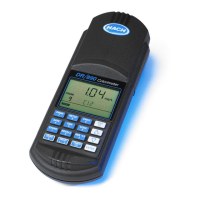28
SECTION 3, continued
important. After the adjustment, it is wise to run standard
solutions of several concentrations to make sure the adjusted
curve is satisfactory. Perform standard additions on typical
samples to help determine if the adjusted curve is acceptable.
Think of the standard adjust measurement as a two-step process.
First, the instrument measures the sample using the
preprogrammed calibration. Second, it multiplies this
measurement by an adjustment factor. The factor is the same for
all concentrations. The instrument will remember the factor
indefinitely and will display the standard adjustment icon when it
is used.
Adjust the calibration curve using the reading obtained with a
Hach Standard Solution or carefully prepared standard made
from a concentrated Hach Standard Solution. It is important to
adjust the curve in the correct concentration range. For most
purposes, Hach recommends adjusting the curve using a standard
concentration that is 70 to 85% of the maximum concentration
range of the test.
For example, the Hach preprogrammed method for fluoride has a
range of 0-2.0 mg/L F. To adjust the calibration curve, use a
standard with a concentration between 1.4-1.6 mg/L. Hach
provides a 1.60 mg/L Fluoride Standard Solution (75% of the full
range). This is a convenient standard to use for adjusting the
calibration curve.
If the range of all your samples is known to be below a
concentration that is less than 50% of the full range (50% of 2.0 is
1.0 mg/L), then adjust the standard curve with a standard that is
within that range.
For example, if all the samples contain 0.6-0.9 mg/L F, you may
use a 1.00 mg/L fluoride standard to adjust the curve. You may
use the 1.00 mg/L standard because it is closer to the sample
range you are working with.
If you are using a Reagent Blank Correction, the blank correction
should be entered before the standard curve is adjusted.
To adjust the standard curve:

